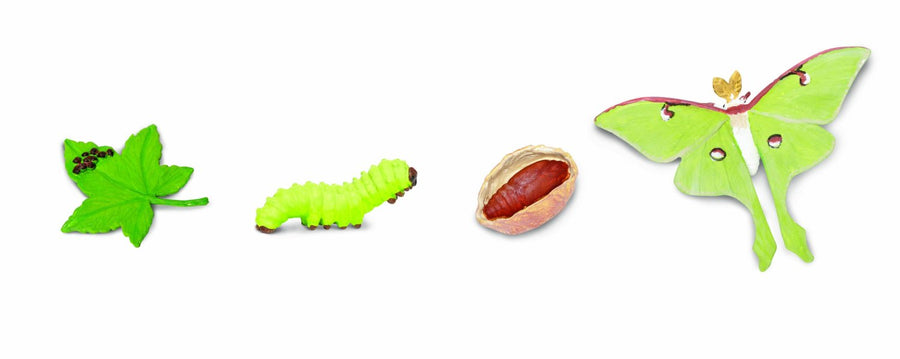
The Enchanting Life of a Luna Moth: A Story of Beauty, Mystery, and a Race Against Time
Everyone loves Luna moths. With their luminous green wings and ghostly short lifespans, they seem like creatures of myth—ephemeral, beautiful, and more than a little mysterious. These delicate giants belong to the silkworm moth family Saturniidae and spend most of their lives preparing for a grand, fleeting finale: just a few short days as a winged adult.
A Long Journey to a Short Life
The Luna moth’s life begins as a tiny egg, nestled on the underside of a leaf. Females can lay between 200 and 400 eggs, either singly or in small groups, each one holding the promise of a future fluttering beauty. Within 10-12 days, the eggs hatch into hungry little caterpillars that have one mission—eat, grow, and eat some more.
These larvae go through five instars (molting phases), shedding their exoskeletons like tiny wardrobe changes. They even snack on their old skins—because why waste a perfectly good protein source? For weeks, all they do is eat, poop, and outgrow their current form, storing up energy for their future transformation. Each instar can last anywhere from 4 to 10 days, depending on the environment. When they’re ready for the next phase, they descend to the ground and spin themselves into a silk cocoon.
The Cocoon: A Secret Chamber of Change
The pupal phase is arguably the most eventful part of a Luna moth’s existence—at least from the outside. Inside, it’s a whirlwind of transformation. If you’ve ever picked up a Luna moth cocoon and felt something squirming inside, that’s because the pupa is surprisingly active, shifting and repositioning as it prepares for its final form.
Under normal conditions, this stage lasts about two weeks, but if the season turns cold, the pupae can enter a dormancy period, waiting up to nine months before emerging as an adult. When the time comes, they release a protein-digesting enzyme to weaken the silk threads of their cocoon and use tiny, built-in spurs on their forewings to cut their way out.
The Grand, Fleeting Finale
Emerging from the cocoon is just the beginning. A freshly emerged Luna moth has swollen, crumpled wings and must spend the next 2-3 hours pumping hemolymph (insect blood) into them, allowing them to expand and harden. Only then can it take to the air—ready for its sole purpose in this final stage of life: to find a mate and continue the cycle.
Here’s where things get even more fascinating—Luna moths don’t have mouths. They emerge with all the energy they’ll ever have, stored as fat from their caterpillar days. With only a maximum of 10 days to live, they devote every ounce of that energy to mating. Once their time runs out, the cycle begins anew, as a new generation of eggs is laid, and the mystery of the Luna moth continues.
A creature of the night, a symbol of transformation, and a living reminder of nature’s fleeting beauty—the Luna moth’s story may be brief, but it’s nothing short of magical.
✨ Tag a fellow Luna moth lover and share the wonder! 🦋💚

my son found a huge Luna moth in caterpillar form we stuck it in a jar the very next day it was in its cocoon shall I leave it in the jar we have it in to see if it hatches I’ve read that it can take anywhere from 2 weeks to 9 months for it to hatch is this correct thanks for any help and advice I don’t want to kill this thing it’s absolutely beautiful just wanted my son to see how it develops
A Luna moth left a group of eggs on my outside towel. What do I do to sustain them for their best growth? We are in Mississippi and the weather is very hot and humid right now.
I found a Luna moth cocoon on an outdoor chair cushion in fall of 2021. Maybe November? About May of 2022 it was still there. I picked it up and could feel movement inside, so I put it in a screened cage. It is still there as of July 8, 2022! The movement seems to be less vigorous than before. I wonder if something is wrong with it. Any advice?
Sharon
A few years ago, I dislodged a cocoon cemented to the bed of my pickup truck. I released the female as soon as I saw her & was able to get a video of her mating the next morning. What a beautiful sight. Thursday & today I found two cocoons. I focused an extra camera on them to record their emergence. Thank you for letting me post this. May 2, 2022
I also caught a Luna moth caterpillar last year, on 9/27. It made its cocoon that day and lived in a very large jar until TODAY!! He hatched this afternoon 4/15 and is simply stunning.